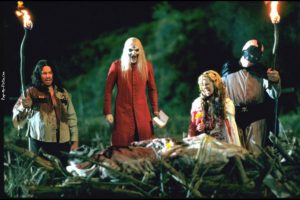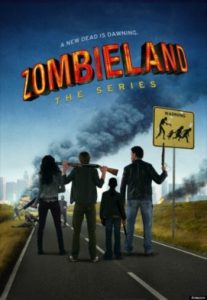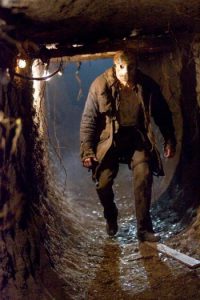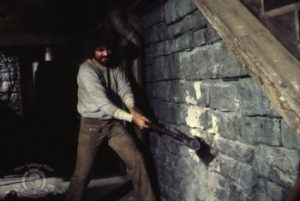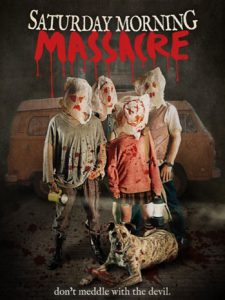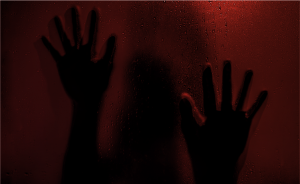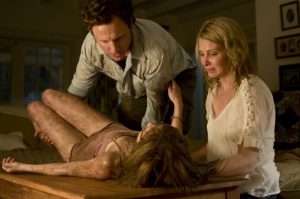Video Nasties: I Spit On Your Grave (1978)
In this new series I’ll be taking a look back at some of the films that, in the early 1980′s, were caught up in the Video Nasties moral panic in the UK. When video first arrived in the UK it was not covered by our censorship laws, and that, combined with the reluctance of the studios to embrace the technology, meant that many of the early releases were lurid, uncensored, horror films.
The tabloid press mounted a campaign against the films, and with a new right wing government in power and the growing influence of pro-censorship campaigner Mary Whitehouse, the Director of Public Prosecutions was instructed to draw up a list of films liable to prosecution under the Obscene Publications Act. I’ll be attempting to look at every one of the 74 films that made this list, giving you a snapshot of the controversy around each film before watching and reviewing it.
THE BAN It’s not hard to see why I Spit On Your Grave became one of the tabloids favourite targets during the moral panic around the nasties. The film was available from two companies; Astra and Wizard, both of whose prints were uncut, even including the misappropriated R rating the film played with in the US. The poster (see right) was lurid and suggestive of extreme brutality, as was the title. Neither were false advertising when you saw the film, and the ability to rewind and rewatch parts of the film (brand new then) spooked commentators into thinking that this could warp the minds of certain viewers. Unfortunately it also meant that they rather missed the point of Mier Zarchi’s film, something that both the mainstream media and the UK censors (who continue to demand extensive cuts for the film to be legally released in the UK) continue to do with disappointing regularity. I Spit On Your Grave was banned in 1984, it remained banned in the UK until 2001. In 2010 it was passed with fewer cuts than ever before; ‘just’ 2 minutes and 54 seconds worth.
THE FILM
I Spit on Your Grave is not, by any means, an easy film. Not easy to watch and, despite its reputation, not easy to dismiss.
In a move that has always baffled me, Roger Ebert, who is a great fan of the original Last House on the Left, has often gone out of his way to denounce this film calling it “A vile bag of garbage” and accusing it of being “Without a shred of artistic distinction“. This seems to have become the default position for ‘respectable’ critics dealing with this film, and while the first quote there is a matter of opinion, the second is simply, demonstrably, wrong.
I Spit on Your Grave is a film of crude technique, but it is also a film of distinct vision and purpose. The shots often feel like they lack design, like director Mier Zarchi just plonked his tripod in the nearest available spot and hoped for the best, but if you give the film some thought, if you look closely at it, that’s quite clearly not the case. The film falls into three quite distinct acts; in the first act Jennifer Hills (Camille Keaton, granddaughter of Buster) arrives in a remote cottage where she plans to write her first novel. In the second act she is raped and beaten by four local men and in the third she recovers and takes bloody revenge on her attackers. Zarchi takes a different approach with each act, and reflects Jennifer’s experience and state of mind with his camerawork throughout. For the first act he shows Jennifer enjoying the wide open space and the privacy provided by her house, before allowing it to be punctured by the noise and nuisance of the men who will later attack her, but it is in the pivotal scenes of Jennifer’s attack that the camera becomes really important.
The second act of I Spit on Your Grave is an ordeal, for the better part of half an hour Jennifer is raped, staggers away from her attackers, is found, and is raped again. What’s striking about Zarchi’s approach to these scenes is how much he makes these scenes about Jennifer, they are scenes about her pain, and about her resolve, and how it is slowly taken away. It is important that these scenes be brutal, because what will come after them is also brutal, and it has to feel justified. It does, because Zarchi never for a second allows his rape scenes to be pleasurable. Keaton is a beautiful woman, and though she’s naked throughout these twenty five minutes of screentime the camera doesn’t dwell on the nudity in any way that seems designed to service the male audience, rather it emphasises Jennifer’s vulnerability. During the actual attacks the focus is often from Jennifer’s POV on the men, really making the attacks feel personal to the audience and that, the extended and brutal nature of the scenes and the continuous suggestions that Jennifer has escaped, only to discover that she hasn’t makes this some of the most upsetting and difficult cinema I’ve seen.
The second act also contains several great horror scenes which demonstrate Zarchi’s skills as both a director and an editor as he builds horrible tension between attacks. Most striking is a moment after Jennifer has escaped the initial attack and is walking through the woods. Having earlier established that one of Jennifer’s attackers plays the harmonica, and used no score during the entire film, Zarchi reintroduces the threat of attack, and pulls the rug from under us just by introducing the harmonica on to the soundtrack. The coming attack becomes ever more inevitable as Zarchi slowly reintroduces each man, having them slowly encircle Jennifer, as if caging her. The pacing and structure of the editing here gives the lie to Ebert’s artistic distinction argument, and the film continues to do so right up until the end, particularly through its use of sound.
The performances of the attackers are, unfortunately, pretty poor, with Richard Pace coming off notably badly as the retarded Matthew (the attacks begin as a way to get him to lose his virginity to Jennifer). However, the film is rescued at an acting level by Camille Keaton, whose remarkable performance goes through many different stages, all of them credibly. She’s perhaps especially good early in the third act as, without dialogue, Jennifer recovers from her ordeal and begins to formulate a plan of vengeance. There’s a lot going on in that sequence, and all of it plays on her face. She also deserves great praise for never letting Jennifer, despite her repeated victimisation, to become simply a passive victim.
The vengeance section of the film is relatively brief, and seems less about dwelling in violence than it does about catharsis. Yes, Jennifer makes the punishments fit the crimes (in a particularly brutal way in one case), but Zarchi seldom dwells in the detail of the violence, again, it’s about Jennifer’s experience of it. This comes across especially strongly after she cuts off one attacker’s manhood, and leaves him to bleed, screaming, while she goes downstairs, listens, then puts a record on. This isn’t to say that Zarchi soft pedals the vengeance though, like the rape scenes these sequences feel painful, but don’t feel as though they are there to be enjoyed. In the case of the revenge sequence it feels like something Jennifer needs to do to close this book (look at the last shot of her powering her boat away down the river).
There are problems with the film. The internal logic lapses here and there (why do the others trust squeamish, retarded, Matthew to finish Jennifer off? Why does Jennifer let Matthew orgasm before killing him?) and the characterisation is incredibly broad, something I must grudgingly admit the remake, though a much less impactful film on the whole, did improve on. Overall though, I Spit On Your Grave is a criminally underrated film. For years it has been dismissed as mere exploitation, and badly made exploitation at that. In fact this is a film that achieves exactly what it sets out to achieve; it discomforts you, and in doing so throws up some thorny moral issues. It’s also generally a very well made film, and more thoughtfully designed than you would think. It’s clearly one of the best films on the video nasties list, and a minor horror classic.




![Best Indie Horror Films [ Part 2 ]](https://www.horror-movies.ca/wp-content/uploads/2021/04/absentia-610x343-2-300x169.jpg)
